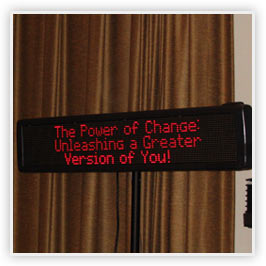What is Open Captioning?
WHAT is Open Captioning: Spoken words translated by a skilled captioner into text onto an electronic sign that looks like a movie marquee
WHO uses Open Captioning: People who are deaf or hard of hearing and speak English, sometimes referred to as oral deaf
WHERE is the electronic sign placed: At the front of your board room, conference or gala, near the people speaking so Open Caption users can read speakers' lips and refer to the Open Captions, to "fill in the blanks"
WHO is the client: Companies, organizations and educational institutions that believe in 100% inclusion of clients, colleagues and employees
Why Companies and organizations Provide Open Captioning
- One in ten people have a hearing loss in the US1 - a total of over 33 million people
- Without captioning, they miss important information in groups or conferences
- Sometimes referred to as oral deaf, they are not signing or "Big D" Deaf. They speak English, not American Sign Language because they’ve lost hearing late in life or, if the loss occurred in childhood, they’ve had speech training and wear hearing aids or a cochlear implant
- Oral deafness is "the invisible disability." Hearing aids and cochlear implants can be concealed under long hair, a hat or may look like a Bluetooth device. Some people do not realize they have a hearing loss and may be reluctant to disclose it at work or ask for help
- One-on-one communication isn’t a challenge for this group of people at conferences, but in a larger setting, people with hearing loss and without communication access are unwittingly excluded
- Breakdowns in communication affect productivity and cause discomfort for all participants
- Captioning, the communication bridge, connects speakers and listeners
- Business leaders that care about 100% inclusion provide captioning
How It Works
- The Open Captioner uses technology to stenotype at over 225 words a minute, with an accuracy rate of 97% or more, to translate speech to text in real time
- Onsite audience views captions on an electronic sign that looks like a movie marquee
- For Intranet Broadcasting, offsite viewers receive simultaneous captioned broadcast on the organization’s intranet. AV experts work with the corporation’s IT team to synchronize live captioning with the intranet broadcast
EVERYONE BENEFITS from intranet and open captioning because they are part of Universal Design. Professionals, scientists and others for whom English is a second language find captioning useful to "fill in the blanks." The hearing community, when momentarily distracted, also refers to captions to "catch up" with the speaker.
Be Heard. Put the  symbol for Open Captioning on your flyers today.
symbol for Open Captioning on your flyers today.
1Statistics provided courtesy of Center for Hearing and Communication www.chchearing.com

